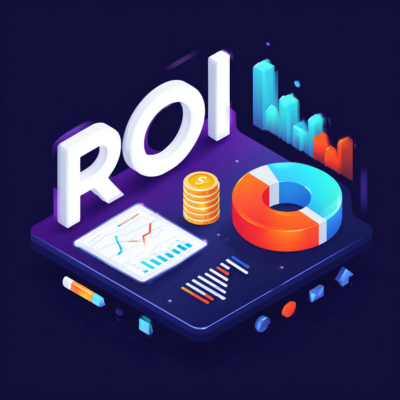
In our recent blogs on analytics ROI, we’ve made the case for a new language, a language that reflects how value is realized in complex, enterprise settings. We’ve looked at the political capital required to prioritize the right work, the portfolio thinking needed to fund AI experimentation, and the dangers of chasing credit instead of alignment.
Now, let’s dig deeper into the Returned Business Value (RBV) framework itself, by first re-visiting why IIA believes this ROI reframe is necessary, along with a closer look at the first pillar of the RBV framework: strategic alignment.

Beyond ROI: A Practical Guide to Communicating Analytics Value
Take a practical approach to proving ROI on analytics—read our expert designed eBook for a step-by-step guide on communicating the value of your projects.
What's the Value of Decision Made 25 Percent Faster?
Analytics professionals collectively are not great at assessing the value of technology efforts. And the process of assessing value gets more complicated with advanced analytics and AI efforts because we’re dealing with a domain in which many of the parties in the conversation have an incomplete understanding.
If you think about the parties involved in assigning value to analytics, these conversations generally have a) a financial party or some kind of an oversight or governance party, b) a technology supplier, and c) a business beneficiary. All three of those parties where advanced analytics and AI are concerned tend to be working outside their comfort zones. For example, in IIA’s experience talking to business beneficiaries, they have a great deal of difficulty assigning value to a solution that solved a problem for them, let alone conceptualizing the application of advanced analytics to problems they’re wrestling with.
If you were to ask the corporate controller how the return on investment would be calculated for a new transaction processing system, she would probably have a very crisp answer for you because the organization has done a good bit of that kind of work already. The promise and the pitfalls are both fairly well understood. If you shifted over and asked about how you calculate the returned business value (RBV) from descriptive BI or data warehouse or AI model, the answer would be more amorphous.
The difference between the two has something to do with organizations’ relative inexperience with an analytics business approach—its technology and its use cases. It also has something to do with the work practices that are modified by the analytics systems and projects. Whereas traditional transaction processing systems are fundamentally designed to reduce the cost of capturing data and running a particular part of the business operationally, when you start to get into questions like “what’s the value of a decision made 25 percent faster or accurate in twice the number of cases?” it becomes much harder to model value. So, analytics practitioners inherit both lack of enterprise familiarity with their technology and lack of understanding about the commercial impact of advanced analytics and AI projects.
Unlike with IT then, we in the analytics and AI space are still dealing with the giant question of what is the value of analytics?
So, with that big question looming over our heads, think about RBV as having two large parts to it: a part that considers the strategic value of engaging in an activity, and a part that considers the commercial value of engaging in an activity. Let’s look at st
Scoring the Qualitative Dimensions of Strategic Alignment
The perceived strategic value of anything, but in particular of investments in advanced analytics infrastructure and projects, is always significantly qualitative and always assessed by reference to the strategic initiatives of the business. If we have three projects competing for a finite amount of human resources and budgetary capital, then we should always be able to stack-rank them in terms of how well they align with or enable whatever the key strategic initiatives or the key operational initiatives are for the business at that time. Some strategic value questions commonly asked about analytics and AI projects are:
- Does it improve my ability to characterize and manage risk?
- Does it improve my competitive posture in the marketplace?
- Does it improve my ability to work with partners or integrate with my ecosystem?
- Does it create new business opportunities that are not available.
All these kinds of soft attributes can be scored, and you can come up with a relative strategic value. Some organizations, for example, place a high value in taking cost out of the business and are much less interested in, or alternatively more dubious of, anything that claims to be a revenue-enhancement activity. In an organization like that, you would tend to prioritize cost containment and cost reduction-oriented projects above revenue-oriented projects. Other organizations are viscerally aware of instability in their markets. These enterprises may be more concerned about their competitive posture and the risks they can’t adequately characterize or even see. For these enterprises, projects focused on competitive posture likely have a higher strategic value.
Moreover, if you had a good strategic fit model and no projects in your project queue, then your strategic fit model would naturally indicate where you should go on the demand side of the information economy (e.g., the business units) to look for projects to put in your queue. If right at the top of the characterization list the highest score goes to projects that improve the competitive posture in the marketplace or give visibility into the competitive posture of competitors, you know where you’re going, and it’s either into supply or into channels and sales.
To get started, use this simple template of criteria to score strategic fit in a way that makes sense for your organization. A score of 1 signifies the least of amount of strategic fit and a score of 5 is the most.
Strategic Fit (Score 1-5)
- Aligns with/enables key strategic initiatives
- Improves risk visibility/management
- Improves competitive posture
- Improves partner or ecosystem integration
- Creates new business opportunities unavailable to momentum business
- Other
In our next article, we’ll explore the benefits and cost dimensions of commercial value.

Why Analytics Value Gets Lost—and How to Fix It
Explore our all-in-one resource hub for analytics ROI. Don’t let outdated ROI math understate your impact. Check out our smarter tools and frameworks for measuring value in analytics and AI—aligned to strategy, outcomes, and real enterprise conditions.